
Resource Links, published 5 times a year is Canada’s national journal devoted to the review and evaluation of Canadian resources for children and young adults.
Resource Links reviews new information books, picture books and novels for children and young adults, audio-visual materials, computer software, and Internet resources for young people and professional literature of interest to teachers and librarians.
Resource Links informs you about Canadian writers, awards and announcements. Everything of interest to a Canadian audience.
Resource Links is written by educators, librarians and writers working with young people across the nation. Our reviewers span the country from British Columbia to Newfoundland.
For subscription information, feature columns, excerpts, and a comprehensive index visit the Resource Links website at www.resourcelinksmagazine.ca.
Refugees and Immigrants
With so many refugees and immigrants arriving in Canada during recent years, we felt that books of this genre would be appropriate at this time. Hopefully they will help classrooms welcome these children and help children understand why many of these children were forced to leave their homes and seek a new home in Canada. These titles have all been reviewed in Volumes 23 and 24 of Resource Links and many are on lists for a number of the Canadian Awards for Children’s and Young Adult Literature. We hope you enjoy these titles!
Picture Books
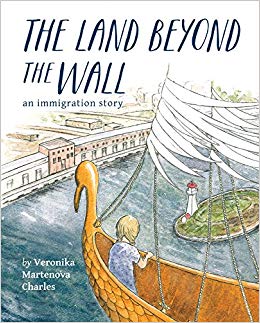 CHARLES, Veronika Martenova
CHARLES, Veronika Martenova
The Land Beyond the Wall: An Immigration Story
Nimbus Publishing, 2017. 32p. Illus. Gr. K-4. 978-177108-465-9. Hdbk. $22.95
Rating G
In this immigration story, author Veronika Martinova Charles shares a version of her personal story (1970) as a sort of fairy tale that has aspects of magic realism. A young girl in a communist country encounters hardship and heartache before escaping to a new country (Canada) full of hope. A talking doll is her companion as she experiences the long voyage and several months at Pier 21 in Halifax (in its last days as a place for new immigrants). Angst and hardship, as well as hope and the potential of new beginnings are portrayed. This is a solid picture book, though the text is sometimes uneven in pace and phrasing.
The final pages show Emma as an adult seated at her drawing table in an image that pays homage to the author and the final page contains a biography of the author’s own immigration journey. The message clearly portrayed is that if the author can thrive in an uncertain situation in a new country, you can, too. This book would be a useful addition to a library immigration collection for young readers. Even recent immigrants would be able to identify with the feelings portrayed in the book, as well as those seeking to learn about the experience.
Thematic Links: Immigration; Canada; Pier 21; Czechoslovakia; Magic Realism
(Reviewed in v. 23, # 1 by Erin Hansen)
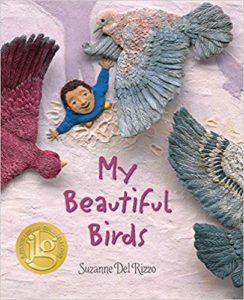 DEL RIZZO, Suzanne
DEL RIZZO, Suzanne
My Beautiful Birds
Pajama Press, 2017. 32p. Gr. P-3. 978-1-77278-010-9. Hdbk. $19.95
Rating: E
My Beautiful Birds tells the story of Sami, a Syrian refugee living with his family in a refugee camp. Sami wishes more than anything that the birds that he used to feed on his rooftop could be there with him in the camp. He longs to be free like his birds, and stays removed from the other children, until a canary, a dove, a rose finch, and a pigeon appear in the camp. The birds inspire Sami to become a part of his new community of refugees and begin to heal.
With its elegant prose and beautiful clay illustrations, this book tells a timely story through the voice of a Syrian refugee. It is important to provide readers with perspectives different than their own, and this book may be particularly relevant for Canadian readers due to the influx of Syrian refugees into Canada.
My Beautiful Birds is a very well-executed book that provides a window into the life of a refugee while also being a pleasure to read.
Thematic Links: Syrian Refugees; Birds
(Reviewed in v. 22, # 3 by Alice Albarda)
 GEORGE, Angela May
GEORGE, Angela May
Out
Illustrated by Owen Swan. Scholastic Canada, 2016. 32p. Illus. Gr. Preschool – 2. 978-1-4431-5730-8. Hdbk. $14.99
Rating: E
This story is very timely in our current political climate. The young girl in the story has fled war with her mother. They escaped on a boat and found safety in a new country. However, she is aware that some call her “an asylum seeker” but she states “that’s not my name.” She goes on to tell her story simply and clearly in a way another child can understand. She is very happy in her new home. Her loving mother has a job. She feels safe, has friends and hope for the future but she misses her father who is still somewhere in a camp.
The muted illustrations are done in watercolour, pencil, and coloured markers on paper. They ably reflect the heartbreaking tenor of each compelling stage of her story.
This is an inspiring resource to be used in all classrooms. The book was originally published in Australia but the experiences described are true to all that is happening to refugees everywhere.
Thematic Links: Refugees; Mothers; Asylum Seekers; War
(Reviewed in v. 22, # 4 by Isobel Lang)
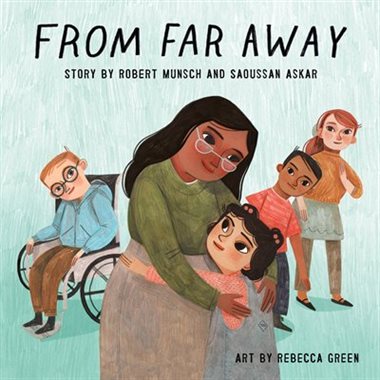 MUNSCH, Robert & Saoussan Askar
MUNSCH, Robert & Saoussan Askar
From Far Away
Illustrated by Rebecca Green. Annick Press, 1995/2017. Unp. Illus. Gr. K-3. 978-1-55451-939-2. Pbk. $11.95
Rating: G
First published in 1995 and reviewed in the very first issue of Resource Links, this book is just as relevant today as it was back then. Munch collaborates with Saoussan Askar who had immigrated to Toronto from Lebanon in 1989 to tell her story of trying to settle into school in a new country with a new language. Unable to understand the language and some of the customs she encounters in her classroom, Saoussan is upset and afraid as she tries to settle in. However, in time, with support from her parents and her teachers, she learns the new language, makes friends and settles in quite well. As she states in the text “Now I am in grade two and I am the best reader and speller in the class. I read and write a lot of stories. The teacher is now complaining that I’m never quiet.” In a note at the end of the book we learn that Saoussan has recently completed a Master of Arts in Sociology at McGill University in Montreal and is currently working on learning German and currently resides in Montreal with her husband.
The original version of this book was illustrated by Michael Martchenko. This reissue has a new illustrator – Rebecca Green – whose bold colour illustrations show a more contemporary era which should make the book more appealing to today’s young readers.
The timing of this reissue is spot on at a time when we have so many refugee immigrants coming into our country from war torn countries with young children facing the same challenges which Saoussan faced back in 1989. I would recommend it for all school and public libraries.
Thematic Links: Immigration; Refugees; School
(Reviewed in v. 23, # 2 by Victoria Pennell)
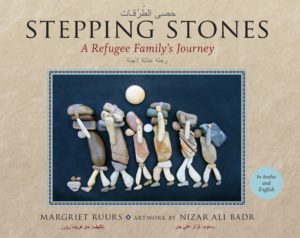 RUURS, Margriet
RUURS, Margriet
Stepping Stones: A Refugee Family`s Journey
Illustrated by Nizar Ali Badr. Orca Book Publishers, 2016. Unp. Illus. Gr. K-6. 979-1-4598-1490-5. Hdbk. $20.00
Rating: E
What a wonderful book! Margriet Ruurs has brought us a wonderful view of the refugee crisis which is currently happening in the Middle East. In free verse style, a child tells of the experience of having lived a free life and then having to flee her homeland due to the war which was happening and causing so much despair. The story is very simply told in both English and Arabic, yet it has a lasting impact as it follows the family on their journey out of what is familiar and into a strange land. Accompanying the story line are the wonderful illustrations all created in stone by Syrian artist Nizar Ali Badr. Actually it was when Ruurs first saw his artistic creations on Facebook that she knew she had to contact this man and have him illustrate a book she wanted to write about current day refugees. The illustrations are amazing, created totally from stones which Nizar Ali Badr collects on the beach. They poignantly display the plight of this family as they leave all they have known behind to seek a new life.
Rurrs includes an extensive introduction in the book which conveys how the book came about and the inspiration she found in Nizar Ali Badr’s illustrations.
This book would be a wonderful way to introduce young children to the refugee crisis that is happening in other parts of the world. Especially now when we have some of these refugee children in our own classrooms throughout the country, the book might inspire some of these children to share their experiences.
I would highly recommend this book for every primary and elementary school in the country.
Partial proceeds from the sale of this book will be donated to resettlement agencies by the publisher and the author will be donating her royalties to help settle more refugees.
Thematic Links: Refugees; Middle East
(Reviewed in v. 22, # 1 by Victoria Pennell)
Fiction Grades 3-6
 WATTS, Irene N.
WATTS, Irene N.
Seeking Refuge
Illustrated by Kathryn E. Shoemaker. Tradewind Books, 2016. 136p. Illus. Gr. 3-7. 978-1926890029. Pbk. $18.95
Rating E
Seeking Refuge is a follow-up to Watts’ book, Good-bye Marianne: A Story of Growing Up in Nazi Germany. The illustrations are in black, white, and grey – reminiscent of black and white movies of the period, giving the story a sense of timelessness, but also lending a sort of coldness and detachedness to 12-year old Marianne Kohn’s strange, new surroundings. Marianne is a little Jewish girl who was sent by her parents out of Germany via Kindertransport, a rescue effort that sought to remove Jewish children from Germany and relocate them with sponsors in Great Britain between 1938 and 1940.
Marianne’s tale is quite sad – she is separated from her home and her family and is placed with an oblivious and unemotional husband and wife in London who care more for social graces and appearances than the feelings of the child they are to care for. The child has to endure taunts for not speaking much English, for pronouncing the English she does know with a German accent, and for being Jewish. Some even accuse her of being a spy once they find out she’s German. Having escaped unimaginable horrors meted out to the Jewish people by the Nazis, Marianne exhibits symptoms of Post-Traumatic Stress Disorder: she has vivid nightmares, sleepwalks, recalls terrifying memories, and has anxiety and fear that the Nazis will find her family through the letters she sends home. While Marianne struggles to calm herself after her vivid and terrifying nightmares and worries about her family still in Germany, her foster family only seems to care about having tea at the appropriate time and making sure Marianne does not embarrass them in public. Amid all this, she does manage to make a good friend at school.
Though this story is set during the Holocaust, Marianne’s struggles more or less mirror what refugees around the world are faced with today as they flee terror and destruction in their homelands: being in a new land where they do not know the language, having their names mispronounced (or even being given a new name), being worried about family back home, trying to keep hope alive even when everything seems gloomy and hopeless, and struggling with being labelled a refugee, and thus, affirming one’s status as an “outsider”. This book illustrates so beautifully and heartbreakingly what it is like for a child who is forced to flee for one’s life. It would be a great resource for lessons and discussions about the Holocaust or about refugees, as it brings a personal touch to these events. This book manages to take a very difficult, even painful subject and frame it in a way that children in upper primary and elementary school grades can handle and understand.
Thematic Links: Holocaust; Refugees; Kindertransport; Post-Traumatic Stress Disorder in Children; War; World War II
(Reviewed in v. 22, # 4 by Catherine Bellamy)
Fiction Grades 7-12
 GRANT, Joyce
GRANT, Joyce
Sliding Home (Lorimer Sports Stories)
James Lorimer & Co., 2018. 132p. Gr. 4-8. 978-1-4594-1284-2. Pbk. $12.95
Rating: G
Miguel and his mother are working very hard to pay their bills, and the legal costs of trying to finish the immigration paperwork for his father, still in El Salvador. The only time Miguel can relax is when he is playing baseball with his Blues team-mates at Christie Pits. But even then, he is self-conscious about his inability to go out to socialize after games, or attend out of town tournaments: his family just can’t afford any extras.
When they finally learn that his father is able to come to Canada, they have to find the money for his flight. Miguel opens up to his team-mates, and they come up with a plan: a community fundraiser and exhibition ball game, where each of the Blues can offer his or her resources to make it a success. Miguel and his team-mates have learned what is possible through teamwork.
Thematic Links: Baseball; Team-mates; Immigration
(Reviewed in v. 23, # 5 by Patricia Jermey)
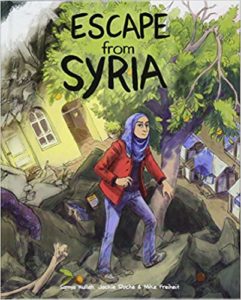 KULLAB, Samya
KULLAB, Samya
Escape from Syria
Illustrated by Jackie Roche and coloured by Mike Freiheit. Firefly Books, 2017. 96p. Gr. 7-12. 978-1-77085-982-9. Hdbk. $19.95
Rating: E
This graphic novel, which details the story of a Syrian family’s harrowing journey to Canada during the Syrian Civil war, was written by Samya Kullab, who reported on Syrian refugees during the war for English-language Lebanese newspaper the Daily Star. The book follows Amina, a young Syrian girl who lives with her parents and little brother and begins with Amina rushing home to show her father the A she got on a test. However, this scene of domestic normalcy is quickly upended by a massive explosion. Kullab uses contrasts like this throughout the novel to highlight the intensity of the chaos that rocked this young family’s life. Drawing on her interviews with Syrian families in the Lebanese refugee camps, Kullab provides realistic and horrifying details of the struggles Amina’s family faced. Warning should be provided to younger or sensitive students picking up this text. Yet, despite dealing with weighty political issues, the book is highly accessible and would be a useful introduction to students interested in learning more about the Syrian conflict. In an appendix, Kullab also expands on many of the issues mentioned throughout the text, providing appropriate context to a complex situation.
In an introduction, Kullab mentions that Amina’s “story is inspired by the strength and determination of the Syrian youth [she’s] encountered” (p. 4). While Amina’s strength is apparent, at times she feels less like an individual person and more like a composite of the experiences of Syrian youth. I would’ve liked to learn more about Amina’s inner life and individual perspective on her circumstances. Regardless, this is an important book that provides a humanizing look at the horrific experiences of Syrian refugees and their quest for freedom.
Thematic Links: Refugees; Civil War; Syria; Politics
(Reviewed in v. 23, # 3, by Natalie Colaiacovo)
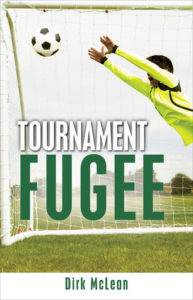 MACLEAN, Dirk
MACLEAN, Dirk
Tournament Fugee
James Lorimer & Co., 2017. 128p. Gr. 7-9. 978-1-4591225-5. Pbk. $8.99
Rating: G
Victor is a young Syrian refugee who has been asked to captain his GTA school soccer team in a national tournament in Vancouver. The Syrian Committee for Thank You Canada Soccer Tournament is the tournament’s official title. The main impediment to Victor’s participation is his parents. They are not convinced the tournament and its sponsoring committee are legitimate. Once Victor’s parents are convinced of the legitimacy of the tournament – the Canadian recruiter, Michael Bridge, is a practicing Muslim who had to leave Syria under cover – Victor is allowed to participate.
Three things are plaguing Victor as he assumes the captainship of his GTA team. The first is the death of Victor’s grandfather while the family was trying to escape from Syria. He was killed by a car when he ran into the road to retrieve Victor’s soccer ball after Victor had been strictly cautioned not to let the ball onto the roadway. The second is the fact that he walked out of a game after an unjust call against him when he was surreptitiously tripped by a member of the opposing team, resulting in a game-winning goal for the opposition. The third is the health of his younger brother who develops pneumonia after an afternoon spent sledding and seems not to be recovering.
Victor takes his preoccupation over the death of his grandfather and the health of his brother with him to the tournament in Vancouver. He does find realistic and genuine resolution for these worries and he learns and grows from his experience captaining the soccer team, showing by example that he is a worthy leader.
However, Victor’s life does not seem to move past the confines of being Syrian in a strange land. And while his story has a universal sense of family and fair play, the only worthy people in this book are those with a religious or refugee connection to Victor. This conundrum could be a valuable lesson in cultural enlightenment if it weren’t for the book’s title. Using the derogatory term Fugee further limits this book’s ability to genuinely reach out to its targeted readership.
Thematic Links: Soccer; Family Life; Syria; Refugee Life
(Reviewed in v. 23, # 1 by Lesley Little)
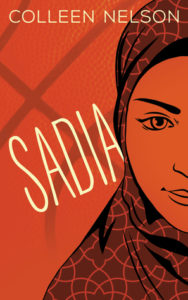 NELSON, Colleen
NELSON, Colleen
Sadia
Dundurn Press, 2018. 235p. Gr. 7-12. 978-1-4597-4029-7. Pbk. $12.99
Rating: E
Fifteen-year-old Sadia began wearing her hijab two years before, alongside her friend Nazreen. But now Nazreen has been de-jabbing and changing into less modest Western clothing once she arrives at school. Sadia doesn’t agree with Nazreen’s choice, but is frustrated when her basketball play is impeded by the flying headscarf and the warm layers of clothing. “My hijab didn’t bother me so much when I was playing sports outside. The rules were loose and everyone else had on their school clothes. But it was a hindrance now, when I was trying out for a team and everyone else was in their gym clothes.” (p. 25) Their relationship is also complicated because both girls are interested in Josh, a non-Muslim boy in their class. Josh encourages Sadia to try out for the co-ed basketball team. But their teacher/coach informs Sadia that her hijab may pose a problem: the tournament rules don’t allow head coverings. Sadia responds, “If they don’t let me play, it’s discrimination. Wearing hijab is part of my religion. This is Canada! Everyone in Canada is equal. I should get to play like the other kids, no matter what I’m wearing.” (p. 91)
Nazreen comes up with a solution: she can sew Sadia a modest head covering and uniform which are sporty and practical. But when they arrive at the tournament, one coach refuses to allow Sadia to play. “I’d never been embarrassed about my religion before. And I still wasn’t. I wasn’t embarrassed to be Muslim, but it was humiliating to be treated differently because I was Muslim.” (pp. 165-166) Her team-mates stand with Sadia, and they win the tournament.
The teacher has also initiated a special project for their Global Issues class, where each student is given a digital camera, and encouraged to use their perspective to show their unique view of the world. Intimate portraits of their home lives and interests create a close bond among the classmates. Sadia and Nazreen are struggling with being Muslim in a predominantly Christian society, Amira is a recent refugee from war-torn Syria, Allan has a physically disabled brother, and Josh’s father is an extreme hockey dad. These revelations lead the students to passion projects, first steps to changing the world.
Nelson has done a great job depicting the Muslim-Canadian experience of these teenage girls, and showing how a good teacher can bring out the best in students. As she says in her Acknowledgements, “Sadia is a book about friendship, acceptance, and standing up for your rights. With all my heart, I hope it reaches an audience of readers who are open-minded and believe in the power of the student voice.” (p. 239)
Thematic Links: Muslim Teens in Canada; Hijab; Basketball; Teamwork; Friendship; Discrimination; Refugees
(Reviewed in v. 23, # 2 by Patricia Jermey)
 STARR, David
STARR, David
Golden Goal
James Lorimer & Co., 2017. 120p. Gr. 5-9. 978-1-459412026. Pbk. $12.95
Rating: G
This novel is the first in a new series about soccer teams comprised of refugees who come to Canada from war-torn areas of the world. By way of introduction, this story begins with young Canadian Dylan’s social and financial displacement after his father dies and his mother is forced to move them from their comfortable home in an affluent neighbourhood to an apartment in a less prestigious neighbourhood served by a less homogenous population.
Dylan’s first impression amongst his new peers is a fist fight with a young Syrian named Assad who he inadvertently fouled during a game in gym class. Although the two are encouraged to apologize, each is unconvinced of his responsibility for the conflict. Dylan is assigned to the school soccer team as a punishment and he is obliged to play forward, as is Assad. Despite being a set-up for continued and increased conflict, the placing of the two combatants on the some team begins a series of events that eventually teaches everyone the value of individual commitment and team spirit; friendship ensues.
During a league game against his former school, Dylan learns the painful lesson of fair weather friendship, the fragile shelf-life of social status and who his real friends are. He also learns that almost everyone on his new soccer team is displaced, some more cruelly than others. He also learns that he has something to offer his team mates and that they have even more to offer him.
Dylan’s new team manages to win the league championship even though Dylan’s obsession to score a goal against his former team almost costs them their win. Assad scores the winning golden goal in overtime because Dylan passes the ball to him, realizing Assad is in a better scoring position. For Dylan, the lesson learned is that the way the game is played is more important than the personal chance to score.
Thematic Links: Soccer; Displacement; Refugees; Family Life; Multiculturalism
(Reviewed in v. 22, # 5 by Lesley Little)
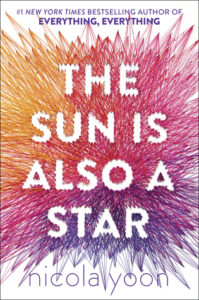 YOON, Nicola
YOON, Nicola
The Sun is Also a Star
Doubleday Canada, 2016. 348p. Gr. 10-12. 978-0-385-68368-5. Hdbk. $21.99
Rating: E
Everyone in the universe is connected. Natasha and Daniel, the two teenage protagonists in The Sun is Also a Star, appear to be total opposites, but in this novel, their connection becomes very apparent. Natasha is an undocumented Jamaican immigrant in New York City, who is going to be deported that evening. She feels that the life and the future she has imagined for herself is over. She has only a few hours to turn prevent disaster for her family. Meanwhile, Daniel, the son of Korean immigrant business owners, is getting ready for a critical university admissions interview to study medicine. The trouble is that he wants to be a poet – not a doctor.
The two young people meet in a strange coincidence involving God, a record store, a theft and Natasha’s cheating ex-boyfriend. Daniel is instantly attracted to Natasha and follows her out of the record store only to save her life. The couple ends up spending the day together as Daniel struggles to convince Natasha that their relationship is “love at first sight.” Their dueling lives have come together, but the reality of the problems that their new relationship creates soon becomes apparent. Will the two young lovers overcome their obstacles?
The Sun is Also a Star is Nicola Yoon’s amazing second novel. It has a unique and innovative narrative structure which uses multiple narrators to tell the story. Natasha and Daniel both tell their own stories incorporating their thoughts and feelings. However, there are also chapters which explain the roles that others play in determining the fate of the two young lovers. For example, Irene is a security guard who impacts Natasha’s life; however, she is struggling with suicidal thoughts. Natasha’s father has created the current crisis in their family. Daniel’s parents struggle with their dreams for their two sons and the realities of 21st century New York City. All the characters have an impact on each other because all of us are connected in this wild and wonderful universe!
The writer also uses sections in her narrative to explain the universal themes addressed in this novel. Beginning in the Prologue, Yoon tells readers that everything in this universe is connected, “Carl Sagan said that if you want to make an apple pie from scratch, you must first invent the universe.” (p. 1). There are also very insightful sections discussing issues such as the nature of God, religion, the universe, family, self-concept, responsibility, physics, science, happiness, fate and love. This novel has something for everyone because, “What a difference a day makes!” (p. 330)
Thematic Links: Undocumented Immigrants; Deportation; Suicide; First Love; Family Relationships; Korean Culture; Jamaican Culture; Social Justice
(Reviewed in v. 22, # 3 by Myra Junyk)
Non-Fiction Preschool – Grade 6
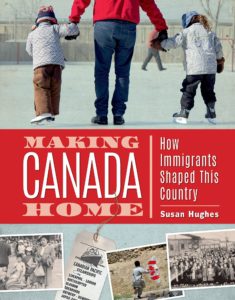 HUGHES, Susan
HUGHES, Susan
Making Canada Home: How Immigrants Shaped This Country
Owlkids Books, 2016. 128p. Illus. Gr. 4-8. 978-1-77147-202-9. Hdbk. $24.95
Rating: E
“Did you know that people from every single country in the world have made Canada their home? In this book you’ll read stories about the many people who came to this land and joined with those already here to help make it the vibrant, multicultural country it is today.” (p.7)
In this book Hughes takes us on an historical journey of the building of a multicultural Canada from Canada’s founding peoples up to the present day. Evidence shows that people have been fishing Canada’s waters and hunting its coastlines for at least 12,000 years. How did they get here? Was it by a land bridge from Asia to North America or did they arrive by boat from Asia, Australia or Siberia? However they arrived they spread out across the country and became the First Nations of our country. The book goes on to look at the arrival of the Europeans and how they established settlements in the late 1400s and 1500s. There are sections about the Acadians, the Quebécois, the Loyalists, Black settlers, Freedom seekers, the British wave, and the Irish in the first section about the Founding Peoples. Other chapters on Building the Nation, Closing the Doors, Welcoming the World have information about Mennonites, Icelanders, Chinese, Italians, Ukranians, Americans, Japanese, War Brides, Hungarians; Vietnamese, Afghanis, and various others who have made Canada their home. Chapter 5 – The Canadian Kaleidoscope – looks at the world cultures, languages and religions that make up Canada today. There is also information included in the book about the times that Canada was not so welcoming to immigrants and practically barred the way in the early 1900s.
The book is arranged in five chapters with 2-page spreads covering a variety of topics related to immigration during the history of the country. Each spread consists of text with bold headings, historical captioned pictures and illustrations and coloured inserts with additional information. A timeline of “1497-2016 World Events and Immigration” is included as well as a page showing Canada’s Immigration Statistics. The book also includes a Table of Contents, a Further Resources page with websites which can be accessed for more information, and an Index.
This book contains quite a lot of interesting information which will be useful to students in the middle and junior high grades who are learning about Canada and how it was populated. At a time when immigration is a high priority for our government, this book will give context to Canada’s position on immigration at the present time. It is also a useful tool to use with classes who have new immigrants in them. As we approach the 150th anniversary of Canada’s Confederation, I expect we will see more of this type of book and this one would be a good one to add to a school or public library collection.
Thematic Links: Canadian Immigration; Canadian Settlement
(Reviewed in v. 22, # 2) by Victoria Pennell
 Leaving My Homeland Series: MASON, Helen. A Refugee’s Journey From Afghanistan (978-0-7787-3125-2); A Refugee’s Journey From Syria (978-0-7787-3128-3); RODGER, Ellen. A Refugee’s Journey From The Democratic Republic of the Congo (978-0-7787-3126-9); A Refugee’s Journey From Iraq (978-0-7787-3127-6)
Leaving My Homeland Series: MASON, Helen. A Refugee’s Journey From Afghanistan (978-0-7787-3125-2); A Refugee’s Journey From Syria (978-0-7787-3128-3); RODGER, Ellen. A Refugee’s Journey From The Democratic Republic of the Congo (978-0-7787-3126-9); A Refugee’s Journey From Iraq (978-0-7787-3127-6)
Crabtree Publishing, 2017. 32p. Illus. Gr. 3-6. Hdbk. $21.56 ea.
Rating: E
This new series from Crabtree is very timely with the refugee crisis which is happening around the world. The books offer the story of a child from each country who has been forced to leave their homeland because of the unrest and war which is taking place there. The books are arranged in an interesting format with alternating two-page spreads telling the story of the child and the story of the country and its past and present situations. The child’s story is written in an italic script and told in the first person which makes it very personal – almost like a personal letter. The very readable text is accompanied by captioned photographs, illustrations and maps. Throughout there are text boxes referring to the various “UN Rights of the Child” and the country’s “Story in Numbers”. There is a “You Can Help!” page at the back of the book along with Discussion Prompts which would be good for use in a classroom. The books contain a table of contents, a glossary, a learning more section and an index.
These books are very well done with interesting text and colourful graphics on coloured pages. The children’s personal stories will give readers a glimpse into what life is like for the many children who have been forced out of their country and way of life and find themselves in refugee camps and foreign countries. The information about the countries also provides an explanation of what is happening in the country and why so many people have to leave.
These books are an excellent addition to the elementary level especially at this time when so many refugees are moving into Canada and becoming part of our classrooms. They can be very helpful in explaining to the students where these new students are coming from and why we need to be mindful of their situation and accepting of them into our society. I would recommend them for all elementary school and public libraries.
Thematic Links: Refugees; Refugee Children; Syria – Refugees; Iraq – Refugees; Afghanistan – Refugees; The Democratic Republic of the Congo – Refugees
(Reviewed in v. 22, # 5 by Victoria Pennell)
(Subsequent titles in this series reviewed in v. 23, # 2 – Leaving My Homeland Series: HUDAK, Heather. A Refugee’s Journal from Guatemala (978-0-7787-3673-8); A Refugee’s Journey From Yemen (978-0-7787-3677-6); RODGER, Ellen. A Refugee’s Journey From South Sudan (978-0-7787-3696-9); A Refugee’s Journey From Myanmar (978-0-7787-3674-5); BARGHOORN, Linda. A Refugee’s Journey from Somalia (978-0-7787-3675-2); A Refugee’s Journey From Colombia (978-0-7787-3672-1). Crabtree Publishing, 2018.)
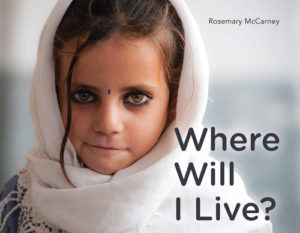 MCCARNEY, Rosemary
MCCARNEY, Rosemary
Where Will I Live?
Second Story Press, 2017. 24p. Illus. Gr. K up. 978-1-77260-028-5. Hdbk. $19.95
Rating: E
This is a very moving book which could be used at any level to promote compassion and action on behalf of the many refugee children who are displaced and wandering the globe. Each photograph is labelled with the country in which it was taken, which adds to the understanding of the size and severity of the problem. The text is simple and is a series of questions, such as “will I find a special buddy?” or “will my new bed be just for me?” which any child can understand.
The author is well known in humanitarian circles in Canada, both for her support of girls’ rights while CEO of Plan International and for her work at the United Nations. Her Rosie Series and Every Day is Malala Day add to the credibility of this book and it will have use in every school and community that provides a welcome to refugees.
Also available in French – Où vais-je vivre? (Éditions Scholastic, 2017.)
Thematic Links: Home; Refugees; Basic Needs
(Reviewed in v. 23, # 1 by Mavis Holder)
 MILWAY, Katie Smith
MILWAY, Katie Smith
The Banana-Leaf Ball: How Play Can Change the World
Illustrated by Shane W. Evans. Kids Can Press, 2017. 32p. Gr. 3-7. 978-1-77138-331-8. Hdbk. $19.95
Rating: E
When men with machetes attack his village, Deo Rukundo and his family flee into the night. When he finally stops running, Deo is alone and very frightened. He keeps moving, eating little, until he reaches the shore of a great lake where a fisherman finds and takes him to Lukoke, a refugee camp in the north west of Tanzania. There, Deo gets food and water, but misses his family and has a hard time making friends.
One day, a man with a whistle around his neck carries a soccer ball through the camp. Children follow him to the playing field, where he throws Deo the ball. Back home, Deo loved playing soccer – a game he calls football. When he shows his skill with the ball, the coach makes him a team captain.
Playing together develops communication and trust between Deo and the other boys in camp. Deo brings out and shares the banana-leaf ball he has made. Soon the whole camp feels more positive as the boys make and play with banana-leaf balls. When the war ends, Deo returns home. Some of his family has survived. He joins them and uses the team-building skills he has learned to coach kids at a local school.
This story is based on the life of Benjamin Nzobonankira, a Burundian who was ten when he arrived in the Lukoke refugee camp, Benjamin received coaching from Right to Play, a group committed to helping children around the world learn teamwork and empathy through sports. Today, he leads Burundi’s national training team.
The book includes a list of groups that use sports to help children around the world learn to cooperate with and trust each other. It is a recommended title would make an excellent introduction to a unit on conflict and change.
Also available in French – Unis par le jeu: Comme le soccer peut changer le monde (Éditions Scholastic, 2017.)
Thematic Links: War; Conflict and Change; Africa; Soccer; Sports and Teamwork; Global Awareness; Inclusiveness; Resilience; Empathy
(Reviewed in v. 22, # 5 by Helen Mason)
 SKRYPUCH, Marsha Forchuk & Tuan Ho
SKRYPUCH, Marsha Forchuk & Tuan Ho
Adrift At Sea: A Vietnamese Boy’s Story of Survival
Illustrated by Brian Deines. Pajama Press, 2016. Unp. Illus. Gr. K-6. 978-1-77278-005-5. Hdbk. $22.95
Rating: E
What a powerful book! Marsha Forchuk Skrypuch and Tuan Ho tell the story of Tuan and his family’s escape from Vietnam in an overcrowded fishing boat in 1981. The story is a true one recounted by Tuan of how he (when he was six years old), his mother, his two sisters and his aunt and cousins made their escape from their home in the middle of the night, avoiding the bullets of the military police as they boarded small boats which took them out to a larger boat which was to take them to freedom. Tuan describes the overcrowded conditions on the boat with the hot sun pouring down on them and very little food and water. On the second day the boat started leaking and then on the third day the motor broke down – the boat was now adrift. On the sixth day the refugees were rescued by an American aircraft carrier which took them to a refugee camp on Bidong Island of the coast of Malaysia. After two and a half months they were moved to Kuala Lampur, Malaysia and three months later they joined their father and older sister in Saskatoon. The remainder of their family made their way to Canada by 1985.
Brian Deines subtle double page oil paintings add greatly to the mood and text of this story. There is also an historical and biographical section at the end of the book which explains the conditions in Vietnam in 1981 and what happened to Tuan Ho’s family as they made a new life for themselves in Canada. Tuan has become a very successful physiotherapist and now has a family of his own.
This book is very timely as we have so many refugees from war torn countries in the Middle East now attempting to make their way to a better life under the same kind of condition that the Vietnamese people experienced back in 1981. With so many refugee children attending schools in Canada now, books like this one can help young children appreciate what some of these children have experienced and develop an empathy for them as they integrate into Canadian society.
I would highly recommend this book for all school and public libraries.
Thematic Link: Vietnamese Refugees
(Reviewed in v.22, # 2 by Victoria Pennell)
Non-Fiction – Grades 7-12
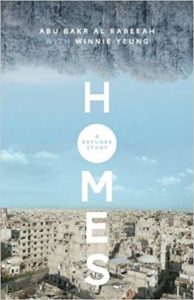 AL RABEEH, Abu Bakr with Winnie Yeung
AL RABEEH, Abu Bakr with Winnie Yeung
Homes: A Refugee Story
Freehand Books, 2018. 220p. Gr. 7-12. 978-1-988298-28-3. Pbk. $19.95
Rating: E
This unadorned true account of a young boy’s journey from childhood and relative safety in his native land through its disintegration and his dangerous journey to eventual safety in Canada is as remarkable as the story of how it came to be told.
Abu Bakr’s journey begins when he is ten and his family moves to Syria because they are Sunni in predominantly Shia Iraq. Direct death threats had prompted the move and it was not easy. It took months to get visas and after a 24 hour bus ride, Abu and his family arrived in Syria. The family endeavoured to make a life for themselves in Syria but the long game put into play by Abu’s father and uncles was to get out of the Middle East altogether.
They succeeded eventually but not without numerous setbacks. Basically, Abu Bakr’s family doggedly went through the required channels and worked hard to support themselves while they waited. Throughout the book, Abu Bakr’s family endeavours to remain true to their religion while maintaining a neutral position as the entire nation degenerates into brutal chaos. Extended family and soccer help Abu Bakr maintain his equilibrium.
The journey out of Syria was fraught with danger until the family reached the airport and their flight to Italy. Abu Bakr recalls the last passport check in Syria, conducted by shabiha, armed militia of the Ba’ath Party. It went like this, after the legitimacy of the family’s exit from Syria was established:
“Ten minutes: that’s how long it took them to check everyone’s documents. I gripped my backpack the entire time. We had lived through shootings, raids, and massacres, but those ten minutes were the most horrifying ten minutes I had ever experienced. When the SUVs finally peeled away, I could breathe again.
Father chucked and looked at me. ‘I think that was our last shabiha squeeze, son.’”
After landing in Edmonton and attending school, Abu Bakr found peace and quiet but also isolation. When his English teacher asked what secret wish he might have, he realized it was to have his family’s story told. The answer to that question is this book.
Thematic Links: Family; Syria; Civil War; Refugees; Intolerance
(Reviewed in v. 22, # 5 by Lesley Little)
 HYDE, Natalie
HYDE, Natalie
Stay Silent: A Refugee’s Escape from Columbia (Arrivals Series)
Clockwise Press, 2016. 143p. Illus. Gr. 6-8. 978-0-9939351-9-0. Pbk. $12.95
RATING: G/E
Stay Silent: A Refugee’s Escape from Columbia is the second title in the Arrivals Series by Clockwise Press. The Arrivals Series is a narrative non-fiction series portraying the life stories of amazing immigrants and refugees from around the world who have come to Canada to seek a better life for themselves and their families; they often contribute successfully to the growth and well-being of the community they eventually call their new home.
Growing up in Columbia was not easy for Paola; her childhood consisted of living in an abusive home with her mother and father. The mother tolerated the abuse and often condoned it as well. Paola’s escape or safe haven from the abuse was the home of her grandmother. Often children who live in this environment grow up fast, as is the case with Paola Gomez. Paola used her intelligence and determination to rise above the abuse and her dismal childhood. Paola quickly rose to success despite the abuse and decided she wanted to help women who were also suffering in abusive spaces. Dedicating her life and work to provide safe havens and shelters for women and children in crisis, Paola soon learned that being “silent” was what the authorities expected and desired. Not being “silent” could lead to many repercussions from those in charge, often resulting in death or a “disappearance”. With the murder of a street child named Wilfred, Paola’s action of standing up to the murderers placed her in danger which led to deaths threats and fear. “Staying silent” was not something Paola believed in, but one night, after being brutally attacked she decided she had no alternative but to leave Columbia.
Stay Silent: A Refugee’s Escape from Columbia is an example of a book that covers and explains the topic of corruption and abuse in the country of Columbia. The author doesn’t use too graphic or horrific descriptions to explain Paola’s plight, but the author doesn’t make the story a flowery example of the struggle in Columbia and of Paola’s escape to freedom.
There are a multitude of “extras” included in the book to help the reader understand the story. An author’s note, a forward (by Paola), and a prologue are found at the beginning of the book. Thirteen chapters follow. There is a timeline, a resources list, a section on how kids can help, an acknowledgements page, and an index. The illustrations consist of two pages of photos (p.77-78) immersed in the middle of the book. All additions provide more information for the reader in helping understand the story of Paola and her life in Columbia and her escape to Canada.
Stay Silent: A Refugees’ Escape from Columbia is an excellent book for classroom discussions in regards to social justice topics. It is well written, not overly complicated in its delivery and message, and will interest many who want to learn more about refugees from a narrative non-fiction book instead of a information non-fiction book. Often this type of story will keep readers engaged longer in understanding the character’s life.
Thematic Links: Refugees; Women’s Rights; Columbia; Social Justice; Overcoming Diversity
(Reviewed in v.22, # 2 by Carmelita Cechetto-Shea)
For subscription information, feature columns, excerpts, and a comprehensive index visit the Resource Links website at www.resourcelinksmagazine.ca.
